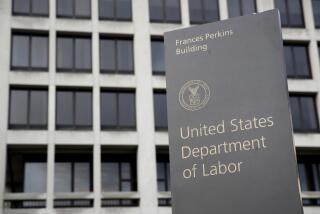Banking rules are greeted with optimism
- Share via
Reporting from New York — The U.S. banking industry breathed a sigh of relief Monday after international regulators proposed new rules dictating how much capital financial institutions must hold.
Most American banks appear to already have more than enough capital to meet the new minimums spelled out in the so-called Basel III accord.
The agreement, announced Sunday after being hammered out in the Swiss town of Basel, is aimed at helping prevent future financial crises and bank bailouts.
Financial stocks shot up Monday on word that the new requirements would be phased in over a longer period than expected. An index of 24 bank stocks jumped 3%.
The sector led a rally by the overall stock market. The Dow industrials rose 81.36 points, or 0.8%, to 10,544.13. The Standard & Poor’s 500 index gained 1.1%.
The rules agreed on by the Committee on Banking Supervision, a global group of central bankers, next goes to the Group of 20 meeting of leading economic powers — to be held in South Korea in November — for approval.
The requirements aren’t binding on national governments, but most countries have based their regulations on previous Basel agreements.
The latest agreement is less strict than what regulators in the U.S. and Britain had sought. In addition, the rules begin to take effect in 2013 but don’t fully kick in until 2019. The U.S. is said to have argued for a transition period of only five years.
“We see this time frame as a generous concession to the banking industry,” Goldman Sachs Group Inc. analyst Richard Ramsden wrote in a note to clients Monday.
Because raising capital levels can depress earnings, many on Wall Street have said for some time that Basel III would affect the industry’s bottom line far more than would the federal regulatory overhaul legislation enacted in the summer.
With both sets of rules laid out, many analysts were talking bullishly about bank shares.
“We find many stocks attractive in our group today,” analysts who follow small and midsize banks for JPMorgan Chase & Co. wrote Monday.
Among large banks, JPMorgan, which weathered the crisis better than most rivals, appears to have plenty of capital to conform with the new rules, according to analyst reports.
Although Bank of America Corp. and Wells Fargo & Co. are widely viewed as the big banks most at risk of falling short of the new capital thresholds, it appears they will comply with the initial requirements in 2013, according to most analysts’ calculations.
Shares of JPMorgan surged 3.4% on Monday, while Bank of America gained 3% and Wells Fargo rose 2.9%.
The most important rule issued Sunday dictates that by 2019, banks should have what is called a core Tier 1 capital ratio of at least 7%, meaning $7 of high-quality capital for every $100 of assets considered at risk of being lost. Currently, that ratio can be as low as 2%.
JPMorgan has a Tier 1 capital ratio of 8.8%, while Bank of America and Citigroup Inc. are below 7%
but should easily top that level by 2013, analysts at Keefe, Bruyette & Woods estimate.
Capital ratios matter to bank shareholders because institutions that have to raise capital will probably be less inclined to raise their dividends.
In addition, among the assets at risk that are counted in calculating the Tier 1 ratio, riskier loans depress it more than other loans do. So banks needing to raise capital might shy away from making riskier loans, giving the lenders more stability but also reducing their profit potential.
The banking regulators also said Sunday that giant banks considered “systemically important” should have to have even higher capital ratios than the 7%, but just how much more has not been decided.
nathaniel.popper@latimes.com
More to Read
Inside the business of entertainment
The Wide Shot brings you news, analysis and insights on everything from streaming wars to production — and what it all means for the future.
You may occasionally receive promotional content from the Los Angeles Times.










